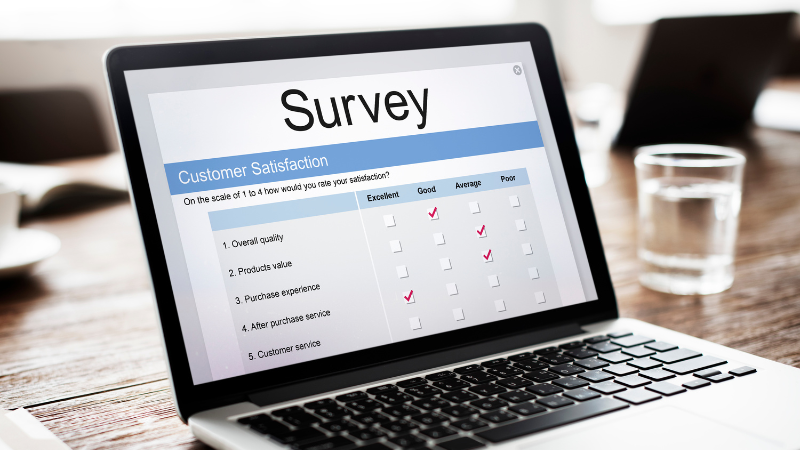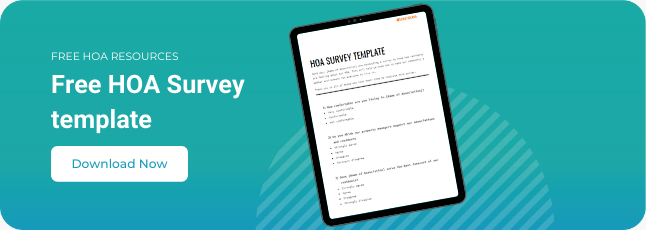As a board member, knowing how your residents feel is crucial to being a great leader. So HOA surveys are key tools to assess your community’s well-being.
In this article, we’ll cover how HOA surveys can help you foster engagement and bring positive change to your community.
However, we know that drafting a survey can be time-consuming. To help, we prepared a free HOA survey template for you. You will find it in this article.
What is an HOA survey?

Put simply, an HOA survey is a questionnaire that board members send to residents. The purpose of this is to gain insight into a specific topic. Usually, these surveys are about assessing the satisfaction of residents. However, they can have other objectives such as asking residents about their preferred HOA events. Or else, figuring out amenities preferences. The board of directors is free to conduct a survey for any matter as long as it is useful.
What should you consider when conducting a survey?
In essence, preparation and brainstorming are essential to enjoy the benefits and avoid pitfalls. Here below is a list of elements that you should always consider.
1. What is the objective?
There are many reasons why a board would need feedback from residents. As we said earlier, you can conduct surveys for different topics such as:
-
- Residents’ satisfaction survey
- Community events-related survey
- HOA Maintenance-related survey
- HOA software-related survey
- Landscaping-related survey
You should also know that nothing prevents you from creating one that covers many topics at the same time.
But, before drafting questions, you should always thoroughly define what is the objective behind them.
2. Who is your audience?
Another important aspect is to define your audience. Do you want all the residents to reply? Or only some in specific units? Maybe you’d like to hear from permanent residents or snowbirds only?
This is really up to you. You need to make sure to send the survey to the right audience. Otherwise, you won’t be able to do much with the information you collected.

3. Questionnaire design
The hardest part of the process is drafting the right questions. First, you must ensure that your questions are easily understandable and unbiased. Second, you need to choose what format your questions will have. There are many different survey question types but they all fall into two categories:
-
- Open-ended questions
- Closed-ended questions
Here are a few examples of questions:
-
- On a scale of 1-10, how strongly would you recommend our community for someone to live in?
- When you want to report a violation, can you easily communicate it with our board?
- Is paying bills to [Name of Association] easy, and well organized?
4. Online survey vs paper survey
While printed surveys may still be an option, online surveys are much easier and more efficient. Nowadays, many platforms allow you to create online surveys at no cost. Even better, some HOA software has its own integrated survey feature. This means board members can use different HOA communication tools in one centralized place. They can easily create a survey and send a notification to all residents. This saves up a lot of time for everyone.
With Neigbrs by Vinteum, you can create surveys, polls and much more. Soon, our management portal will also include an Elections tab, ensuring full legal compliance for your Condo or HOA.

5. Sharing the results and follow-up actions
The most transparent thing a board can do is to share the survey results with the homeowners. Without doing that, your residents probably won’t participate in the next one. The best practice is to take the time to analyze the results and create a plan of action. Once you’ve done that you can present the results and actions during an HOA meeting for example.
Benefits and risks of doing HOA surveys
While gathering feedback has many benefits, it can have the opposite effect when not done properly.
Conducting HOA surveys promote a fairer and more democratic living environment. They can also help reduce complaints from residents. Homeowners feel like their voices matter. Surveys help create a sense of belonging to the community.
Sometimes, the board is reluctant to do surveys because of the fear of dealing with negative feedback. However, in many cases, results show a lot of positive insights. This can help motivate the board to keep up with the great work.
Risks:
One common mistake HOAs do is to overuse surveys. If you do that, residents will become less engaged. It also increases the board’s workload since they have to analyze and follow up with the results.
Another common mispractice is the lack of action once the survey is closed. It is essential to take the time to analyze the results. It is also important to turn feedback into action.
Last but not least, you may be receiving negative feedback. This can be tough to read. So make sure to remind residents that only constructive criticism is accepted. Insults or aggressive answers should never be tolerated.
Key takeaways: HOA Surveys
Without a doubt, HOA surveys are great management and communication tools. They allow board members to improve and take action. On the other hand, resident participation increases. Not to mention that several out-of-the-box ideas or solutions come up through surveys. As a result, everyone enjoys a better community.
Creating a survey from scratch can be a time-consuming process. So to help you we created a survey template featuring the most common questions. Download it, customize it, and use it to gather feedback in your HOA.
Ready to simplify your HOA management? Experience the power of seamless communication, document management, and resident engagement with Neigbrs.
Book your free demo today by filling out our quick form, and discover how our platform can help your community thrive!


